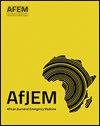Acute trauma care training in undergraduate medical education programs in Uganda; A cross-sectional survey of final year medical students
IF 1.2
4区 医学
Q3 EMERGENCY MEDICINE
引用次数: 0
Abstract
Introduction
Trauma is one of the leading causes of death and long-term disability globally. In sub-Saharan Africa, the number of specialist emergency care personnel is inadequate and task shifting is common. We aimed to assess the variation in knowledge on acute trauma care, and self-perceived confidence in performing lifesaving skills amongst final year medical students in Uganda.
Methods
We conducted a multi-institutional, cross-sectional survey among final year medical students who had just completed their training from eight medical schools in Uganda. We assessed knowledge using a 25 standardized multiple-choice question test adopted from a previous study, and self-reported confidence in perfuming lifesaving skills, scored on a 5-Point Likert scale.
Results
Some 246 (88.5 %) participants responded to the survey and 241 provided complete data. The mean knowledge score was 58.9 % (SD; 12.4) with a mean variation ratio of 0.36 (SD; 0.17). The mean self-perceived confidence score of the participants was 3.8 (SD; 1.0) with relatively high scores in interpretation of radiological investigations (mean 4.2, SD; 0.9) and patient assessment (mean 4.1, SD; 0.9), and lower scores in management of different categories of trauma patients (mean 3.8, SD; 1.0) and performing life-saving procedures (mean 3.5, SD; 0.9). Only three institutions had emergency medicine physicians, with one at each institution, and 146 (60.6 %) of participants received no dedicated trauma training.
Conclusion
Final year medical students exiting training in Uganda had variable knowledge in acute trauma care and intermediate self-perceived confidence in performing lifesaving skills. Training programs need to standardize and strengthen acute trauma training and provide specialists and resources essential for trauma training at undergraduate level.
乌干达本科医学教育项目中的急性创伤护理培训;对毕业班医学生的横断面调查
创伤是全球死亡和长期残疾的主要原因之一。在撒哈拉以南非洲,专业急救人员数量不足,任务转移很常见。我们的目的是评估乌干达最后一年医科学生在急性创伤护理知识的差异,以及在执行救生技能方面的自我感知信心。方法我们对乌干达八所医学院刚完成培训的最后一年级医学生进行了多机构横断面调查。我们使用先前研究中采用的25个标准化选择题测试来评估知识,并根据5分李克特量表对香水救生技能的自我报告信心进行评估。结果246人(88.5%)回复问卷,241人提供完整资料。平均知识得分为58.9% (SD;12.4),平均变异比为0.36 (SD;0.17)。参与者的自我知觉自信平均得分为3.8分(SD;1.0),在放射学调查的解释方面得分相对较高(平均4.2,SD;0.9)和患者评估(平均4.1,SD;在不同类型创伤患者的管理中得分较低(平均3.8,SD;1.0)和执行救生程序(平均3.5,SD;0.9)。只有三个机构有急诊医生,每个机构有一名,146名(60.6%)参与者没有接受专门的创伤培训。结论在乌干达接受培训的最后一年医学生对急性创伤护理的知识参差不齐,对执行救生技能的自我认知信心中等。培训计划需要规范和加强急性创伤培训,并为本科水平的创伤培训提供必要的专家和资源。
本文章由计算机程序翻译,如有差异,请以英文原文为准。
求助全文
约1分钟内获得全文
求助全文
来源期刊

African Journal of Emergency Medicine
EMERGENCY MEDICINE-
CiteScore
2.40
自引率
7.70%
发文量
78
审稿时长
85 days
 求助内容:
求助内容: 应助结果提醒方式:
应助结果提醒方式:


